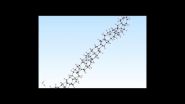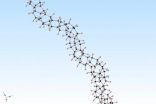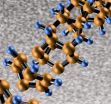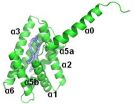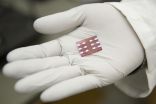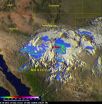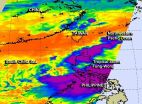(Press-News.org) VIDEO:
For the first time, scientists have discovered how to produce ultra-thin 'diamond nanothreads' that promise extraordinary properties, including strength and stiffness greater than that of today's strongest nanotubes and polymers....
Click here for more information.
For the first time, scientists have discovered how to produce ultra-thin "diamond nanothreads" that promise extraordinary properties, including strength and stiffness greater than that of today's strongest nanotubes and polymers. A paper describing this discovery by a research team led by John V. Badding, a professor of chemistry at Penn State University, will be published in the 21 September 2014 issue of the journal Nature Materials.
"From a fundamental-science point of view, our discovery is intriguing because the threads we formed have a structure that has never been seen before," Badding said. The core of the nanothreads that Badding's team made is a long, thin strand of carbon atoms arranged just like the fundamental unit of a diamond's structure -- zig-zag "cyclohexane" rings of six carbon atoms bound together, in which each carbon is surrounded by others in the strong triangular-pyramid shape of a tetrahedron. "It is as if an incredible jeweler has strung together the smallest possible diamonds into a long miniature necklace," Badding said. "Because this thread is diamond at heart, we expect that it will prove to be extraordinarily stiff, extraordinarily strong, and extraordinarily useful."
The team's discovery comes after nearly a century of failed attempts by other labs to compress separate carbon-containing molecules like liquid benzene into an ordered, diamondlike nanomaterial. "We used the large high-pressure Paris-Edinburgh device at Oak Ridge National Laboratory to compress a 6-millimeter-wide amount of benzene -- a gigantic amount compared with previous experiments," said Malcolm Guthrie of the Carnegie Institution for Science, a coauthor of the research paper. "We discovered that slowly releasing the pressure after sufficient compression at normal room temperature gave the carbon atoms the time they needed to react with each other and to link up in a highly ordered chain of single-file carbon tetrahedrons, forming these diamond-core nanothreads."
Badding's team is the first to coax molecules containing carbon atoms to form the strong tetrahedron shape, then link each tetrahedron end to end to form a long, thin nanothread. He describes the thread's width as phenomenally small, only a few atoms across, hundreds of thousands of times smaller than an optical fiber, enormously thinner that an average human hair. "Theory by our co-author Vin Crespi suggests that this is potentially the strongest, stiffest material possible, while also being light in weight," he said.
The molecule they compressed is benzene -- a flat ring containing six carbon atoms and six hydrogen atoms. The resulting diamond-core nanothread is surrounded by a halo of hydrogen atoms. During the compression process, the scientists report, the flat benzene molecules stack together, bend, and break apart. Then, as the researchers slowly release the pressure, the atoms reconnect in an entirely different yet very orderly way. The result is a structure that has carbon in the tetrahedral configuration of diamond with hydrogens hanging out to the side and each tetrahedron bonded with another to form a long, thin, nanothread.
"It really is surprising that this kind of organization happens," Badding said. "That the atoms of the benzene molecules link themselves together at room temperature to make a thread is shocking to chemists and physicists. Considering earlier experiments, we think that, when the benzene molecule breaks under very high pressure, its atoms want to grab onto something else but they can't move around because the pressure removes all the space between them. This benzene then becomes highly reactive so that, when we release the pressure very slowly, an orderly polymerization reaction happens that forms the diamond-core nanothread."
The scientists confirmed the structure of their diamond nanothreads with a number of techniques at Penn State, Oak Ridge, Arizona State University, and the Carnegie Institution for Science, including X-ray diffraction, neutron diffraction, Raman spectroscopy, first-principle calculations, transmission electron microscopy, and solid-state nuclear magnetic resonance (NMR). Parts of these first diamond nanothreads appear to be somewhat less than perfect, so improving their structure is a continuing goal of Badding's research program. He also wants to discover how to make more of them. "The high pressures that we used to make the first diamond nanothread material limit our production capacity to only a couple of cubic millimeters at a time, so we are not yet making enough of it to be useful on an industrial scale," Badding said. "One of our science goals is to remove that limitation by figuring out the chemistry necessary to make these diamond nanothreads under more practical conditions."
The nanothread also may be the first member of a new class of diamond-like nanomaterials based on a strong tetrahedral core. "Our discovery that we can use the natural alignment of the benzene molecules to guide the formation of this new diamond nanothread material is really interesting because it opens the possibility of making many other kinds of molecules based on carbon and hydrogen," Badding said. "You can attach all kinds of other atoms around a core of carbon and hydrogen. The dream is to be able to add other atoms that would be incorporated into the resulting nanothread. By pressurizing whatever liquid we design, we may be able to make an enormous number of different materials."
Potential applications that most interest Badding are those that would be vastly improved by having exceedingly strong, stiff, and light materials -- especially those that could help to protect the atmosphere, including lighter, more fuel-efficient, and therefore less-polluting vehicles. "One of our wildest dreams for the nanomaterials we are developing is that they could be used to make the super-strong, lightweight cables that would make possible the construction of a "space elevator", which so far has existed only as a science-fiction idea," Badding said.
INFORMATION:
In addition to Badding at Penn State and Guthrie at the Carnegie Institution, other members of the research team include George D. Cody at the Carnegie Institution, Stephen K. Davidowski, at Arizona State, and Thomas C. Fitzgibbons, En-shi Xu, Vincent H. Crespi, and Nasim Alem at Penn State. Penn State affiliations include the Department of Chemistry, the Materials Research Institute, the Department of Physics, and the Department of Materials Science and Engineering. This research received financial support as part of the Energy Frontier Research in Extreme Environments (EFree) Center, and Energy Frontier Research Center funded by the U.S. Department of Energy (Office of Science award #DE-SC0001057).
[ Barbara K. Kennedy ]
CONTACTS
John V. Badding: jvb2@psu.edu, 814-777-3054
Barbara K. Kennedy (PIO): science@psu.edu, 814-863-4682
VIDEO and IMAGES
After the embargo lifts, a video and images will be published online along with this press release at http://science.psu.edu/news-and-events/2014news/Badding9-2014
Smallest possible diamonds form ultra-thin nanothreads
Diamond nanothreads are likely to have extraordinary properties, including strength and stiffness greater than that of today's strongest nanotubes and polymers
2014-09-21
ELSE PRESS RELEASES FROM THIS DATE:
New cancer drug target involving lipid chemical messengers
2014-09-19
PHILADELPHIA — More than half of human cancers have abnormally upregulated chemical signals related to lipid metabolism, yet how these signals are controlled during tumor formation is not fully understood.
Youhai Chen, PhD, MD, and Svetlana Fayngerts, PhD, both researchers in the department of Pathology and Laboratory Medicine at the Perelman School of Medicine, University of Pennsylvania, and colleagues report that TIPE3, a newly described oncogenic protein, promotes cancer by targeting these pathways.
Lipid second messengers play cardinal roles in relaying and amplifying ...
Melanoma risk found to have genetic determinant
2014-09-19
(Lebanon, NH 9/18/14)— A leading Dartmouth researcher, working with The Melanoma Genetics Consortium, GenoMEL, an international research consortium, co-authored a paper published today in the Journal of the National Cancer Institute that proves longer telomeres increase the risk of melanoma.
"For the first time, we have established that the genes controlling the length of these telomeres play a part in the risk of developing melanoma," said lead author of the study Mark Iles, PhD, School of Medicine at the University of Leeds (UK).
Telomeres are a part of the genome ...
UChicago-Argonne National Lab team improves solar-cell efficiency
2014-09-19
New light has been shed on solar power generation using devices made with polymers, thanks to a collaboration between scientists in the University of Chicago's chemistry department, the Institute for Molecular Engineering, and Argonne National Laboratory.
Researchers identified a new polymer — a type of large molecule that forms plastics and other familiar materials — which improved the efficiency of solar cells. The group also determined the method by which the polymer improved the cells' efficiency. The polymer allowed electrical charges to move more easily throughout ...
Research predicts possible 6,800 new Ebola cases this month
2014-09-19
Tempe, Ariz. (Sept. 19, 2014) - New research published today in the online journal PLoS Outbreaks predicts new Ebola cases could reach 6,800 in West Africa by the end of the month if new control measures are not enacted.
Arizona State University and Harvard University researchers also discovered through modelling analysis that the rate of rise in cases significantly increased in August in Liberia and Guinea, around the time that a mass quarantine was put in place, indicating that the mass quarantine efforts may have made the outbreak worse than it would have been otherwise. ...
Domestic violence likely more frequent for same-sex couples
2014-09-19
CHICAGO --- Domestic violence occurs at least as frequently, and likely even more so, between same-sex couples compared to opposite-sex couples, according to a review of literature by Northwestern Medicine scientists.
Previous studies, when analyzed together, indicate that domestic violence affects 25 percent to 75 percent of lesbian, gay and bisexual individuals. However, a lack of representative data and underreporting of abuse paints an incomplete picture of the true landscape, suggesting even higher rates. An estimated one in four heterosexual women experience domestic ...
A better way to track emerging cell therapies using MRIs
2014-09-19
Cellular therapeutics – using intact cells to treat and cure disease – is a hugely promising new approach in medicine but it is hindered by the inability of doctors and scientists to effectively track the movements, destination and persistence of these cells in patients without resorting to invasive procedures, like tissue sampling.
In a paper published September 17 in the online journal Magnetic Resonance in Medicine, researchers at the University of California, San Diego School of Medicine, University of Pittsburgh and elsewhere describe the first human tests of using ...
NASA catches a weaker Edouard, headed toward Azores
2014-09-19
NASA's Aqua satellite passed over the Atlantic Ocean and captured a picture of Tropical Storm Edouard as it continues to weaken. The National Hurricane Center expects Edouard to affect the western Azores over the next two days.
NASA's Aqua satellite flew over Tropical Storm Edouard on Sept. 18 at 1:45 p.m. EDT and the Moderate Resolution Imaging Spectroradiometer (MODIS) instrument took a visible picture that showed the eye had disappeared and the bulk of clouds pushed east of center.
At 5 a.m. EDT on Sept. 19, Edouard's maximum sustained winds had decreased to near ...
NASA, NOAA satellites show Odile's remnant romp through southern US
2014-09-19
Former Hurricane Odile may be a bad memory for Baja California, but the remnants have moved over New Mexico and Texas where they are expected to bring rainfall there. NASA's TRMM satellite measured Odile's heavy rainfall rates on Sept. 18, and NOAA's GOES-West satellite saw the clouds associated with the former storm continue to linger over the U.S. Southwest on Sept. 19.
The remnants of Hurricane Odile were dropping heavy rain in the area from southern Arizona to western Texas when NASA-JAXA's Tropical Rainfall Measuring Mission or TRMM satellite flew over on September ...
NASA sees Tropical Storm playing polo with western Mexico
2014-09-19
Tropical Storm Polo is riding along the coast of western Mexico like horses in the game of his namesake. NASA's Aqua satellite saw Polo about 300 miles south-southeast of Baja California on its track north.
NASA's Aqua satellite flew over Polo on Sept. 18 at 4:35 p.m. EDT and the Moderate Resolution Imaging Spectroradiometer captured a visible image of the storm that showed that much of the clouds, thunderstorms and showers were west and south of the center of circulation, and away from the coast. That's an indication that easterly wind shear had increased and were pushing ...
NASA eyes Tropical Storm Fung-Wong move through Northwestern Pacific
2014-09-19
Tropical Storm Fung-Wong continued to affect the Philippines while moving north through the Northwestern Pacific Ocean. NASA's Aqua satellite provided infrared data on the storm's clouds that showed some high, strong thunderstorms with the potential for heavy rainfall over the northern and central regions of the country. The storm is now expected to affect three more countries over the next several days.
The AIRS instrument aboard NASA's Aqua satellite uses infrared light to read cloud top temperatures in tropical cyclones. When Aqua passed over Fung-Wong infrared data ...
LAST 30 PRESS RELEASES:
Tracing the quick synthesis of an industrially important catalyst
New software sheds light on cancer’s hidden genetic networks
UT Health San Antonio awarded $3 million in CPRIT grants to bolster cancer research and prevention efforts in South Texas
Third symposium spotlights global challenge of new contaminants in China’s fight against pollution
From straw to soil harmony: International team reveals how biochar supercharges carbon-smart farming
Myeloma: How AI is redrawing the map of cancer care
Manhattan E. Charurat, Ph.D., MHS invested as the Homer and Martha Gudelsky Distinguished Professor in Medicine at the University of Maryland School of Medicine
Insilico Medicine’s Pharma.AI Q4 Winter Launch Recap: Revolutionizing drug discovery with cutting-edge AI innovations, accelerating the path to pharmaceutical superintelligence
Nanoplastics have diet-dependent impacts on digestive system health
Brain neuron death occurs throughout life and increases with age, a natural human protein drug may halt neuron death in Alzheimer’s disease
SPIE and CLP announce the recipients of the 2025 Advanced Photonics Young Innovator Award
Lessons from the Caldor Fire’s Christmas Valley ‘Miracle’
Ant societies rose by trading individual protection for collective power
Research reveals how ancient viral DNA shapes early embryonic development
A molecular gatekeeper that controls protein synthesis
New ‘cloaking device’ concept to shield sensitive tech from magnetic fields
Researchers show impact of mountain building and climate change on alpine biodiversity
Study models the transition from Neanderthals to modern humans in Europe
University of Phoenix College of Doctoral Studies releases white paper on AI-driven skilling to reduce burnout and restore worker autonomy
AIs fail at the game of visual “telephone”
The levers for a sustainable food system
Potential changes in US homelessness by ending federal support for housing first programs
Vulnerability of large language models to prompt injection when providing medical advice
Researchers develop new system for high-energy-density, long-life, multi-electron transfer bromine-based flow batteries
Ending federal support for housing first programs could increase U.S. homelessness by 5% in one year, new JAMA study finds
New research uncovers molecular ‘safety switch’ shielding cancers from immune attack
Bacteria resisting viral infection can still sink carbon to ocean floor
Younger biological age may increase depression risk in older women during COVID-19
Bharat Innovates 2026 National Basecamp Showcases India’s Most Promising Deep-Tech Ventures
Here’s what determines whether your income level rises or falls
[Press-News.org] Smallest possible diamonds form ultra-thin nanothreadsDiamond nanothreads are likely to have extraordinary properties, including strength and stiffness greater than that of today's strongest nanotubes and polymers
